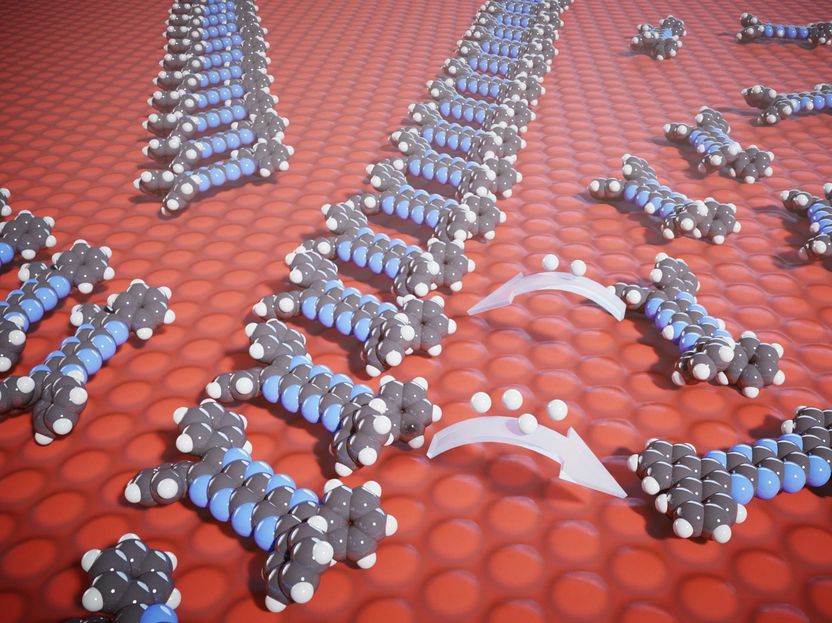Chemist develops X-ray vision for quality assurance
It is seldom sufficient to read the declaration of contents if you need to know precisely what substances a product contains. In fact, to do this you need to be a highly skilled chemist or to have genuine X-ray vision so that you can look directly into the molecular structure of the various substances. Christian Grundahl Frankær, a Postdoc at DTU Chemical Engineering, is almost both, as he has developed a method that allows him to use X-rays to look deep into biological samples.
The 'Fingerprints' of a Substance
The technique is called 'powder diffraction' and involves subjecting a sample to an intense beam of X-rays. Powder diffraction is currently used to identify simple substances such as sugar, salts and minerals, but the idea of using the same technique to characterize advanced biological molecules such as proteins is truly innovative. It is for this reason that the method has enormous potential in both food production and the pharmaceutical industry, where more and more attention is being devoted to protein-based medicines.
"I have tested different types of infant milk formula, protein powders and detergents. By taking a small sample of powder and bombarding it with X-rays, I can determine what substances the powder containsand in what concentrationswithin ten minutes. In addition, the analysis will typically reveal some information about how the product was made," relates Christian Grundahl Frankær. The method is therefore ideal for quality assurance of new products on the market.
Crystal Forms Determine Properties
Proteins are large molecules with complex 3D structures. The shape of a protein or its crystal structure can significantly alter its properties. A protein such as insulin may have many different crystal forms, and the form the substance appears in may affect its solubility or level of activity. This, in turn, may be of significance to how the protein will react when it enters the human body. For this reason, it makes a lot of sense to analyse the crystal forms of different proteins both during production and in the quality assurance of protein-based medicines, but this has simply not been practical nor financially viable until now. Christian Grundahl Frankær explains:
"We have now demonstrated that powder diffraction can actually be used on biological substances such as proteins. The results are not as detailed as in single crystal diffraction, which makes it possible to decode the entire structure of the protein, but they do allow us to 'lift fingerprints' quickly and easily so that we can identify the protein and its crystal structure. This is valuable knowledge when you are working with the production of proteins."
Quick Answer
The method has great potential in the context of optimizing both quality and production processes in all production set-ups that involve solid substances. Applying the new method will make it possible to check continuously for changes inor transformations ofdifferent substances used in the production process.
"The advantage of our method is that it allows you to take samples directly from a production line. You then have the results within 15 minutes and can tell precisely what crystalline material is involved. In addition, the X-ray beams we use can easily be generated using standard laboratory equipment," relates Christian Grundahl Frankær. The encouraging results are only the beginning.
"What we want to do now is to test how far we can push the method. We have already established that it works on proteins, but will it also work on other complex products? And what happens if we take the samples to the synchrotron in Grenoble, where the X-ray beam is a million times more powerful than the one we have in our laboratory?" asks Christian Grundahl Frankær.
Most read news
Organizations
Other news from the department science

Get the chemical industry in your inbox
By submitting this form you agree that LUMITOS AG will send you the newsletter(s) selected above by email. Your data will not be passed on to third parties. Your data will be stored and processed in accordance with our data protection regulations. LUMITOS may contact you by email for the purpose of advertising or market and opinion surveys. You can revoke your consent at any time without giving reasons to LUMITOS AG, Ernst-Augustin-Str. 2, 12489 Berlin, Germany or by e-mail at revoke@lumitos.com with effect for the future. In addition, each email contains a link to unsubscribe from the corresponding newsletter.
Most read news
More news from our other portals
Last viewed contents
Daniel_B._Smith

























































